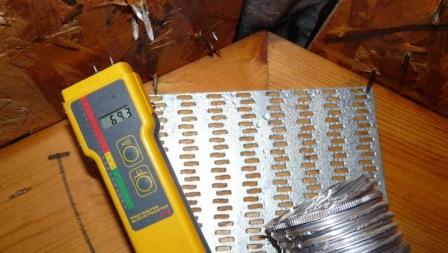Mastering Roof Inspections: Roof Penetrations, Part 4
by Kenton Shepard and Nick Gromicko, CMI®
When you inspect inside attics, pay attention to combustion vent connections. If vent sections have not been fastened together with screws as they should be, then when roofers pull the vent jack for re-roofing operations, they may separate the exhaust flue inside the attic/living space. This can allow the toxic byproducts of combustion to enter the living space, which can be dangerous or even fatal to people living in the home.

This home is in the mountains of Colorado, and the vent was disconnected during the winter. This furnace vent separated when the vent on the roof was pulled during re-roofing operations.

These sections were never screwed together like they should have been. When the vent jack on the roof was replaced during re-roofing operations, a gap of several inches remained open in the attic space.

The sections had been reconnected several days before this photo was taken, but ice visible on the underside of the roof sheathing was the result of frozen moisture from the furnace exhaust gas, which was discharging into the attic for about 10 days.

Even several days after the vent was re-connected, moisture levels in framing materials were still as high as 70%. Mold fungi can become active at around 20%, and mold colonies start to produce spores and grow at about 27%.

Combustion vents are sometimes very tall, especially on roofs with steep pitches. Combustion vents over 5 feet tall should be braced.

If you see a short vent like this 4-inch cast iron one, you should try to determine whether it’s connected to a combustion appliance. If it is, it’s defective for two reasons.
The first reason is that it has no cap. This may allow the entry of pests or the accumulation of debris, such as nest-building materials and leaves.
The second is that it’s too short to draw adequately and may result in the byproducts of combustion entering the living space.
If it’s no longer connected, it should be sealed to keep out moisture.
This is an old plumbing stack vent. It’s part of the drain, waste and vent system. You can never be sure unless you check.
This is also a good example of bad flashing of all three vents.


You should also comment on deteriorated vents. Vents which have advanced corrosion should be replaced.

Lastly, combustion vents should not be used as water pipes. Someone routed the water supply pipe to the roof-mounted evaporative cooler through the jack for this furnace vent.
Stack Vents
Plumbing stack vents are usually black plastic ABS pipe, but in some parts of the country, you’ll see them made of lead.

Remember to check the rubber or plastic gasket. It's sometimes called the “boot” that seals the pipe against the metal jack.


You’ll see some imaginative methods for replacing cracked boots. Here’s the “welcome mat” method.

The minimum termination height for a plumbing stack vents varies by state. It’s 6 inches in many states, but especially in northern states like Minnesota, it’s 12 inches.


A flashing detail common to different vent penetrations is that flashing is overlapped by shingles or tiles on the uphill side, and it overlaps them on the downhill side.
This is true for most roof-covering materials. The exception is metal panel roofs, and that detail will be covered in detail an article covering metal roofs.


Vents that rely on sealant alone to prevent moisture intrusion are improper installations.
In cold climates, you may see vents that have been bent by sliding snow. This is more common on metal roofs.
In some areas subject to frost, the 2006 IRC requires a minimum diameter of 3 inches for any portion of the plumbing vent extending above the roof. This is to help keep the opening from freezing over. But you should check local requirements before you call a 2-inch vent a defect.


You should also pay attention to the location of vents in the roof. Installing a vent in a valley is always a bad idea due to the increased potential for leakage. When you find this condition, it should be mentioned in your report.


**************************************************
Learn how to master a roof inspection from beginning to end by reading the entire InterNACHI series: Mastering Roof Inspections.
Take InterNACHI’s free, online Roofing Inspection Course
Mastering Roof Inspections
Roofing Underlayment Types
Inspecting Underlayment on Roofs
Fall-Arrest Systems
Roofing (consumer-targeted)
More inspection articles like this

